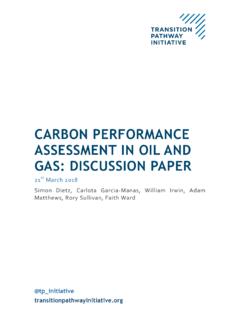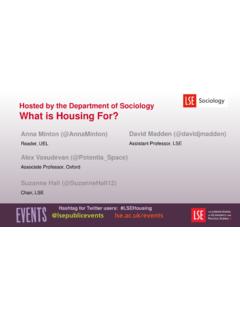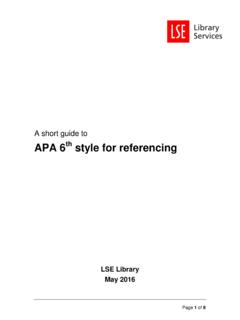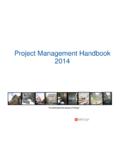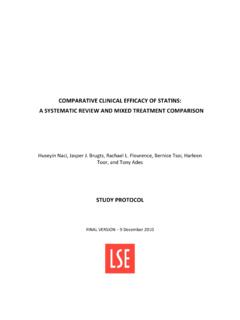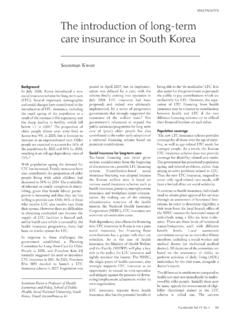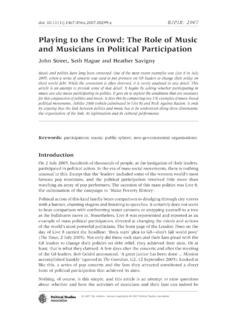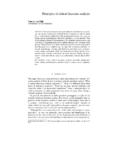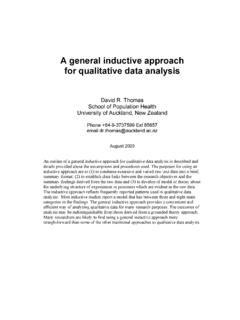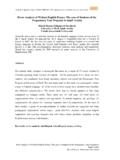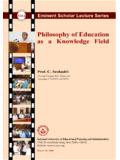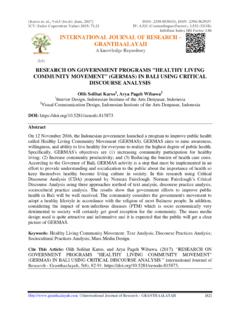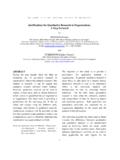Transcription of Theories of Change in International Development ...
1 JSRP Paper 17 Theories of Change in International Development : Communication, Learning, or Accountability? Craig Valters August 2014 Acknowledgements: This paper benefitted from the useful comments of Matthew Arnold (The Asia Foundation), Patrick Barron (The Asia Foundation), Lisa Denney (Overseas Development Institute), Ramani Jayasundere (The Asia Foundation), Henry Radice (London School of Economics and Political Science), Mareike Schomerus (London School of Economics and Political Science) and Danielle Stein (Effective Development Group). This paper would not have been possible without the constructive, critical and patient approach of The Asia Foundation, whose staff facilitated and participated in this research throughout.
2 The author retains sole responsibility for the findings of this paper. Craig Valters, 2014 Although every effort is made to ensure the accuracy and reliability of material published in this paper, the Justice and Security Research Programme and the LSE accept no responsibility for the veracity of claims or accuracy of information provided by contributors. All rights reserved. No part of this publication may be reproduced, stored in a retrieval system, or transmitted in any form or by any means without the prior permission of the publisher, nor be issued to the public or circulated in any form other than that in which it is published.
3 Requests for permission to reproduce any part of this paper should be sent to: The Editor, Justice and Security Research Programme, International Development Department, LSE, Houghton Street, London WC2A 2AE Or by email to: Abstract Critically analysing assumptions is a much needed endeavour in International Development policy and practice: existing management tools rarely encourage critical thinking and there are considerable political, organisational and bureaucratic constraints to the promotion of learning throughout the sector. The Theory of Change approach an increasingly popular management tool and discourse in Development hopes to Change some of that.
4 This approach explicitly aims to challenge and Change implicit assumptions in world views and programme interventions in the lives of others, yet little is known about the extent to which it really does so. This paper provides a much needed analysis of how Theories of Change are used in the day-to-day practice of an International Development organisation, The Asia Foundation. They use the approach in three ways: to communicate, to learn and to be held accountable, which each exist in some tension with each other. Creating Theories of Change was often found to be a helpful process by programme staff, since it provided a greater freedom to explain and analyse programme interventions.
5 However, the introduction of the approach also had some troubling effects, for example, by creating top-down accounts of Change which spoke more to donor interests than to the ground realities of people affected by these interventions. Ultimately, this paper argues that while a Theory of Change approach can create space for critical reflection, this requires a much broader commitment to learning from individuals, organisations, and the Development sector itself. Contents 1. Introduction .. 1 The problem ..1 aims and 2. The Theory of Change approach .. 3 Where did it come from and what should it do?
6 3 Existing debates ..4 The Asia Foundation s approach ..5 3. An organisational view .. 6 Communication ..6 Learning ..8 Accountability ..10 4. The effect of Development discourses .. 13 Results ..13 Evidence ..16 5. Rethinking the Theory of Change approach .. 17 Six key findings ..18 Conclusion ..20 Bibliography .. 21 1 1. Introduction The problem Many of our assumptions about how the world works are based on implicit Theories of Change , based on our worldview, developed through our education and upbringing. Eyben et al. argue that they may have become so embedded that we no longer question whether they are the most useful for our purpose, or if we are using them as well as we could.
7 "1 In the International Development industry, which (ostensibly at least) aims to improve the well-being of people often in very different places and situations, critical reflection on these assumptions is essential; in one more limited sense so that interventions do no harm , and more optimistically to ensure they genuinely improve the lives of those at the receiving end. This is not only about critically analysing overarching world views, but deconstructing the basic assumptions which underpin programme interventions to determine whether they make sense in changing the lives of others.
8 Problematically, the dominant models and tools for analysing and evaluating Change processes in International Development tend to constrain rather than promote such critical reflection. So, for example, it is fairly common for donors and aid organisations to support the training of historically violent police forces in conflict-affected countries. This is a complex and morally perilous undertaking; and such an intervention may rest upon multiple (and sometimes competing or contradictory) Theories of social Change , linked to differing understandings of how individual behaviour and context-specific cultures of practice can be shaped.
9 What we need to know is what assumptions underpin that intervention? Do those assumptions hold true over the life of the programme? To readers outside the Development industry, it might be taken as rather obvious that these questions need answering. But to those within, they will recognise some familiar problems and debates. Management tools used within the aid industry most obviously the logical framework (logframe) approach rarely allow the flexibility to analyse the messy social processes that these interventions are dealing with. Measures of success through such approaches tend to be pared down to, for example, counting police officers trained, which while an important thing to know, tells us little about whether the training has been effective or not.
10 Ultimately, there are many ways of learning about and assessing dynamics of Change , but the ones that the aid industry is most strictly expected to use are not really fit for purpose. Critically analysing our assumptions is not simply limited by choice of management tool but also by the power relations embedded in the aid industry. For example, implementing organisations are rarely incentivised to present the complexity of their interventions to donors, since admitting the unpredictability of Change through an intervention doesn t inspire confidence that the programme will get results and in turn get them funding however realistic and honest that assessment is.
